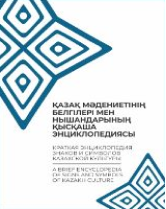




Black is the counterpart of white. It is rightly one of the three most symbolic colours. But it has different meanings in world culture. In ancient Indian mythology, this colour corresponds to tamas, a state of depression and oppression; in Buddhism, to the darkness of ignorance; and in Confucianism, black is associated with wisdom and knowledge.
The semantic meaning of black in Turkic culture is also characterised by numerous shades of diverse, sometimes polarised meanings. The word “black” has more than twenty figurative meanings in Turkic culture. On the one hand, it is a symbol of sorrow, suffering, calamity, and is used as an exaggeration of the bad, negative. For example: qara bas – lonely; qarabet, zhüziqara – shameless, dishonourable; qara könil – grief, etc. In general, it is a colour indicator of the underworld – the realm of Erlik. Kazakhs have a custom to put up qara tu – a mourning banner – on the anniversary of a nobleman’s death, which is removed at the funeral feast at the end of the year.
On the other hand, black denoted “old”, “powerful”, “strong”, “great”, “chief”, etc. For example, qara shanyraq (sacred or parental house), qara qazan (sacred hearth), qara zher (sacred land), etc. Moreover, in relation to water, black can denote the concept of “depth” (for example, “qara su”). In this sense, the musical genre “qara ölen” correlates with the expression “alive, original, timeless”.
The word “qara” refers to the north side, the land of the dead, and is also used to refer to the ancient, the powerful, the living, and so on.
When considering the semantics of black, one cannot ignore the religious significance of the artistic contrast of black and white (or white and black), which is clearly evident in a creative product of folk art – the syrmak (felt rug). This contrasting two-colour solution of the carpet surface symbolises the evolution of life, the alternation of day and night, a kind of Kazakh “yin-yang” – the union of the male and female.
The symbolic combination of white and black can be used in Kazakh culture as a colour-semiotic expression of the ambivalence of certain things, phenomena and so on. The connection of white and black or (black and white) has been artistically expressed in Kazakh felt syrmaq, where the equivalence of white patterns on a dark background can be seen as the duality of the world, the equivalence of good and evil in life, etc.
Moreover, the well-known expression “közdin ağy men qarasyndai köru, qorğau” means “to cherish like the apple of one’s eye” and “közdin ağy men qarasyndai” (literally, “like the whites and pupils of the eyes”) is understood as “the most precious, priceless, the only”.
In general, the juxtaposition of these colours traditionally shows a binary opposition of opposite entities: light and darkness, good and evil, sadness and joy, etc.


